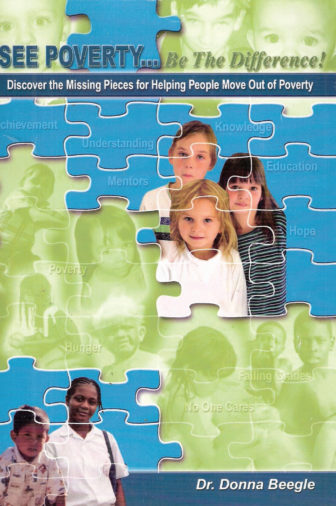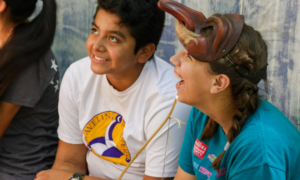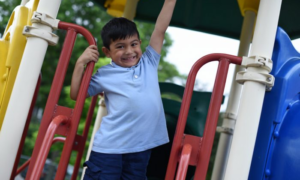 Donna M. Beegle, Ph.D.
Donna M. Beegle, Ph.D.
Communications Across Barriers
200 pages
2007
“For generations, my family has subsisted on minimum-wage employment and migrant work,” writes Donna Beegle in the opening of “See Poverty…Be the Difference! Discover the Missing Pieces for Helping People Move Out of Poverty.”
“Although we worked hard doing migrant labor work and temporary minimum-wage jobs, we were constantly being evicted, going hungry, and struggling with poverty.”
This situation is, sadly, the reality for all too many Americans. As regular Americans struggle to get the minimum wage raised to a livable wage, Congress balks and gives themselves pay raises. As migrant and temporary workers call for wage protections, Congress allows corporations to funnel American jobs overseas and transform salaried jobs with benefits and other protections into independent contractor positions, devoid of any benefits. Education costs continue to skyrocket, and the benefits of education are not so easily seen by those joining the job market. Instead we have professors on food stamps. Many Americans, it is widely known, are one serious illness away from falling into dire poverty.
Beegle discusses these issues of poverty in three easy-to-use sections of her book. The first section, A Foundation for Understanding Poverty, section tells of Beegle’s own experience with poverty before opening outward into social and political analysis.
Beegle is candid about her experience of growing up in a family that lived in poverty for generations. She is equally candid about the educational divide that other children growing up in poverty also face: the “stress of trying to arrive on time, of having the right clothing, shoes, lunch and materials for homework projects”.
Beegle describes the other challenges of intergenerational poverty she experienced: a lack of role models, lack of options, lack of trust in authority figures, lack of prenatal nutrition and health care, lack of knowledge of available resources, lack of understanding that one could have expectations and ask questions of one’s children’s teachers.
After her divorce, Beegle and her two children were eligible to receive $408 in welfare from the state. But with rent at $395, they constantly faced impossible choices. It wasn’t that they needed to manage their money better; there was no money to manage. Luckily, Beegle was led to a women’s group that helped her learn to navigate the system and obtain her GED. Because of them, other mentors who believed in her and supported her, and family who encouraged her, Beegle was able to obtain her associates degree, four-year college degree, master’s degree and then her doctorate.
By opening with her own story, Beegle brings the experience of living in poverty from the abstract to the personal. She then analyzes class and wealth in the United States, and articulates key facts about poverty: “that the United States has the highest childhood poverty rate among the developed nations,” for example.
Beegle then spends some time noting the key systematic and internal barriers people face in overcoming poverty. Unique to authors who write about poverty, Beegle devotes a section to commending the strengths of people in poverty, who tend to be more “relationship-based, spontaneous, repetitious, holistic, emotional, present oriented and physical,” she writes, quoting from a study done by Walter J. Ong in 1982.
The second section of “See Poverty” explores different action plans providers can take to serve. Beegle posits, “the main goals for helping people out of poverty are to help them see possibilities for success, believe in their worth, and recognize that they have something to offer.” She explores the importance of relationship-based models of support and positive reinforcement, as well as other tools in breaking the cycle of poverty.
The book’s third section takes a step outward to explore how we can create a cultural shift for institutional and systemic change in how we regard and distribute poverty and wealth. Building responsive organizations and engaging with the culture to shift the conversation on poverty, Beegle believes, offer a wealth of room for change.
Beegle offers an insightful analysis of the causes of poverty as well as ways to mitigate it on a practical level, grounded by her own life experience. Here is a useful text for any youth worker dealing with youth or families affected by poverty. Beegle reminds us of the power of one-on-one mentoring, the sharing of cultural capital, and encouragement as primary interpersonal tools for allowing youth from poverty backgrounds to rise above and thrive.
Further Reading:
“Welfare Realities: From Rhetoric to Reform,” by Bane M., and D.T. Ellwood, Harvard University Press, 1996, 238 pages. An accounting of key issues and perspectives in the welfare debate.
“Poverty in America: A Book of Readings,” by L.A Ferman, J.L. Kornbluh, and Alan Haber, University of Michigan Press, 1965, 702 pages. A comprehensive anthology reflecting upon the causes and possible cures for poverty in the United States
“The Other America: Poverty in the United States,” by M. Harrington, Touchstone Books, 1997, 252 pages. A painstaking account of the deliberate, systematic poverty groups of Americans, particularly Black Americans, are subject to.






























